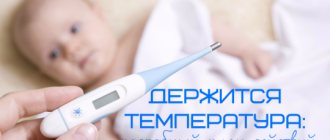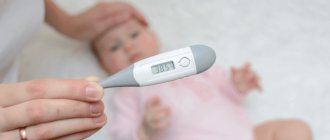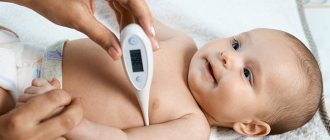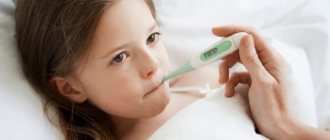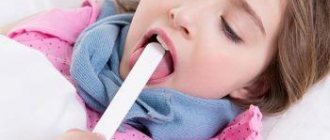12/04/2020 557 Pediatrics
Author: Elena
If a child’s temperature is 39°C and the general condition is easily controlled, then there is no need to worry too much. But the absence of accompanying symptoms should cause concern, since this is a fairly high thermal threshold, signaling a sharp deterioration in the baby’s condition. The source of any heat is the body’s reaction to the occurrence of pathology, the invasion of a virus or infection. This leads to destabilization of the processes of heat transfer and heat production, which are balanced in a healthy body.
[Hide]
Causes
A moderately febrile temperature (39 degrees) may indicate a serious illness. There are few reasons for the rise in temperature and they all have pronounced symptoms.
Hyperthermia
A sharp increase in body temperature above 38.5-39°C is a condition characteristic of newborns and children of the first year of life.
The following factors can trigger the development of hyperthermia:
- Overheating of the body. Most often observed in infants who are dressed too warmly by caring parents. The imperfection of the thermoregulation system provokes a sharp increase in body temperature in the baby, impaired breathing and heart rhythm. Symptoms of overheating are easily eliminated if the child is undressed and given water.
- Reaction to teething. Often accompanied by high fever. The child is nervous, refuses to eat, sleeps poorly, and has increased salivation.
- Viral or bacterial infection most often entails fever and is accompanied by cough, diarrhea, vomiting, and rash. The problem requires immediate consultation with a specialist.
Infectious diseases
A high body temperature that occurs in the absence of acute respiratory infections symptoms may indicate the development of the following infectious diseases:
- Stomatitis. Characteristic signs of the disease are purulent rashes on the oral mucosa. The child refuses to eat, gets nervous, and cries.
- Pharyngitis. The clinical picture of the disease is manifested by redness and rashes on the mucous membranes of the larynx.
- Angina. Throat diseases, which are characterized by the presence of white purulent plaque on the tonsils. The temperature during a sore throat persists until the breeding ground for pathogenic bacteria is eliminated. As a rule, treatment of sore throat is rarely complete without taking antibiotics.
- Otitis is an inflammation of the middle ear. In a one-year-old child who cannot yet speak, the development of otitis media can be suspected by high body temperature and characteristic gestures (the baby covers the sore ear with his palm or does not allow him to touch it).
- Roseola. The disease occurs against the background of enlarged lymph nodes and moderate febrile temperature, which can be brought down only on the third day. After the fever passes, characteristic pink spots appear on the child's body.
- Intestinal infections (rotavirus, salmonellosis, enterovirus, dysentery). Pathogenic microorganisms, entering the child’s gastrointestinal tract, produce toxic substances that provoke hyperthermia, abdominal pain, vomiting and diarrhea.
- Tuberculosis. During the incubation period, as a rule, there are no signs of pathology, but within two weeks from the moment of infection, headaches, fever, and cough may occur.
- Pneumonia. With a typical type of pneumonia, the temperature begins to rise sharply, a cough with sputum appears, and sometimes pleural pain is observed.
- Measles. The disease develops very quickly and is accompanied by fever. After the incubation period, the child may experience a runny nose, dry cough, conjunctivitis and other symptoms. One of the characteristic signs is the appearance of red spots on the hard and soft palate.
- Chicken pox. Most often, in children, the rash period is painless, but an increase in temperature may be observed.
- Scarlet fever. The disease begins with fever, headache and general malaise. Always accompanied by a sore throat and rash. On days 2-4, the tongue becomes grainy and bright red.
Acute inflammatory diseases
No less often, the cause of high fever in infants is acute inflammatory diseases, such as:
- Meningitis. Most pathologies caused by disorders of the functioning of the brain provoke fever. The child also has nervousness, nausea, hallucinations, and sleep disturbances.
- Pathologies of the genitourinary system (cystitis, pyelonephritis). Symptoms: pain, cramps and cramps in the abdomen, child complaints of difficulty urinating.
- Inflammatory processes in the abdominal cavity (appendicitis, pancreatitis, cholecystitis, intestinal obstruction). Their signs: pain on palpation of the abdomen, lack of appetite.
Oncological pathology
The emergence and development of malignant tumors in a child may also be accompanied by high body temperature.
In this case, additional symptoms occur, such as:
- lack of appetite, resulting in exhaustion of the body;
- general state of weakness;
- drowsiness and apathy;
- frequent bleeding;
- pale skin;
- the occurrence of bruises and hematomas at the slightest blow.
In this case, it is necessary to undergo a complete examination of the body as soon as possible in order to exclude the worst suspicions of cancer.
Danger signs
The exact temperature at which you need to call an ambulance depends on the age of the baby, the disease that caused the fever, and accompanying symptoms. Call your doctor immediately if:
- The infant is less than three months old and has a rectal temperature of 38°C.
- An older child, the thermometer readings are above 39° C.
Call your pediatrician if your baby has a temperature below 38°C but has dangerous signs:
- Diarrhea or profuse vomiting, sometimes with bile or blood.
- The baby refuses water or cannot drink.
- Sore throat or ear.
- The fever persists for more than 24 hours in a child under 2 years old, or 72 hours in a child older than two.
- Rash, bright purple spots on the skin.
- Pain when urinating.
You should seek urgent medical help if you experience the following symptoms:
- Prolonged crying.
- Irritability, fussiness.
- Slowness, drowsiness.
- Hard breath.
- Dehydration of the body.
- Blue or pale skin.
- The fontanel protrudes or flows inward.
- Strong headache.
- Leaning forward and drooling from the mouth.
- Loss of consciousness.
Meningitis
You should immediately consult a doctor or call an ambulance for emergency hospitalization if your baby, in addition to fever, has symptoms of meningitis:
- hallucinations;
- profuse vomiting;
- stiff neck (cannot lower the chin to the chest or pain when tilting the head forward);
- purple-red rash on the body.
Dehydration
Fever causes symptoms that are life-threatening to the baby, especially infants. Possible dehydration, which has signs:
- dry mouth;
- lack of tears;
- sunken eyes;
- hard dry skin;
- sunken fontanel in infants;
- infrequent urination.
If you notice such symptoms, give your baby water at room temperature - one sip every ten minutes. If your newborn is breastfed, put him to the breast more often.
If you become dehydrated, you should immediately consult a doctor. Otherwise, death is possible.
What to do in case of high temperature?
Until the specialist determines the nature of the development of the fever, it is important to provide the most comfortable conditions under which the fever will not increase.
In the room where the child is located, the air temperature should not exceed 20° C and the humidity level should not exceed 60%. The air must be fresh. The room where the patient is located must be ventilated several times a day. There is no need to wrap your baby up; allow him to move freely in light clothing.
At high temperatures, the child needs to be given water as often as possible. Offer him clean water, herbal teas, diluted juices and fruit drinks, and if breastfeeding, milk.
Additional information about what to do at elevated temperatures is presented in the video filmed by the “Question to the Doctor” channel.
Drug treatment
Antipyretic drugs will help reduce a child’s temperature above 39:
- Paracetamol. The safest drug. For children over 3 months of age, experts recommend the use of Paracetamol in the form of a suspension or suppository. For children over three years old - tablets. The antipyretic effect of rectal suppositories begins within 40 minutes after administration, and for drugs taken orally - after 20 minutes.
- Ibuprofen. In addition to excellent antipyretic properties, it has a good anti-inflammatory effect. Most often used in the complex treatment of bacterial infections. Prescribed for children from 6 months.
- Analgin. As a rule, it is administered intramuscularly, in the form of an injection. It is used in severe conditions when other drugs do not have the necessary effect at a high temperature in a child. Can be prescribed to children from 1 year.
Paracetamol (20 rub.)
Analgin (13 rub.)
Ibuprofen (7 rub.)
It is important for parents to remember situations when taking medications is ineffective and immediate emergency medical attention is required:
- body temperature rose above 39.1°C;
- fever caused the development of seizures;
- loss of consciousness and hallucinations are observed;
- vomiting, diarrhea, difficulty breathing appeared;
- a child has a temperature of 39°C for more than a day when taking antipyretic drugs;
- it is impossible to adequately assess the baby’s condition on one’s own;
- after visible improvements, the temperature rose sharply again;
- the child refuses to drink and there are signs of dehydration.
Antipyretics
Medications that can reduce fever work in almost the same way. Their effect on thermoregulatory centers in the brain causes increased sweat production. It is thanks to skin evaporation that the high temperature begins to decrease.
The following medications are most often used to reduce fever in children:
- Nurofen.
- Paracetamol.
- Ibuprofen.
It has been noted that paracetamol relieves fever well only in acute respiratory viral infections, while Ibuprofen and Nurofen are considered stronger drugs. In pharmacies they are sold in the form of tablets, capsules, suspensions and suppositories.
What not to do?
If a child’s body temperature exceeds 39 degrees, it is strictly prohibited:
- Independently determine the cause of the inflammatory process and begin treatment without prior consultation with a specialist.
- Use alcohol wipes.
- Apply ice. Such actions provoke vasospasm and worsen the baby’s condition.
- Give several antipyretics at the same time.
- Wrap up a child and restrict his freedom of movement. The exception is chills.
- Give an enema yourself.
- Force feed. At high temperatures, it is better to drink more than eat.
- Take a hot bath. Such actions can provoke a deterioration in the baby’s condition.
- Leaving a child alone with a high fever. The body's reaction is unpredictable; at any moment the baby's condition can deteriorate sharply.
Baby fever
Thermoregulation in the body is controlled by the hypothalamus, located in the brain. If the centers of heat release and production are in balance, then the body temperature is 36.6-37° C.
Fever in children is a common symptom that signals the development of infectious diseases in the body, which occurs in 95% of cases in all children under six years of age.
Harmful microorganisms produce pyrogens. These substances affect the hypothalamus, which increases the temperature. The body begins to fight the disease on its own by activating the immune system. A high temperature may rise gradually over the course of a day or suddenly over one or two hours. At the same time, the child feels discomfort, chills, and when the readings drop, he sweats profusely. If your baby doesn't drink enough, dehydration may occur.
Video
You can learn more about the reasons for the rise in temperature and the rules of first aid in the video from the channel “Nyankovsky University of Healthy Child”.
Do you have any questions? Specialists and readers of the KROHABABY website will help you ask a question
Was this article helpful?
Thank you for your opinion!
The article was useful. Please share the information with your friends.
Yes (100.00%)
No
X
Please write what is wrong and leave recommendations on the article
Cancel reply
Rate the benefit of the article: Rate the author ( 2 votes, average: 5.00 out of 5)
Discuss the article:



